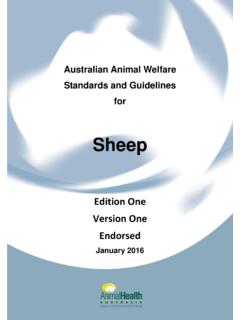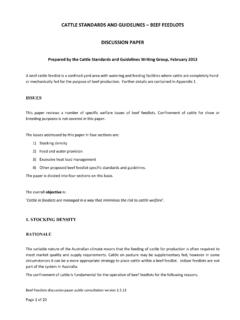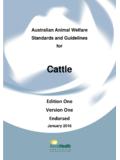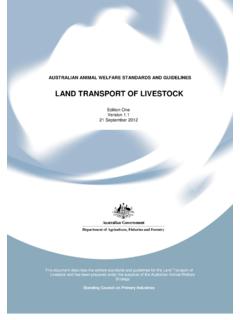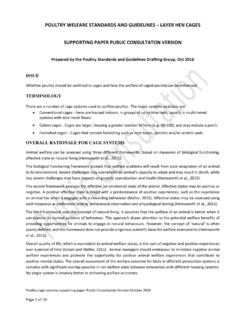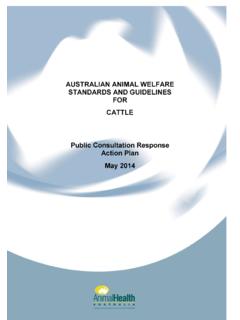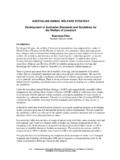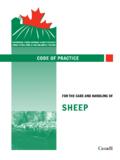Transcription of SHEEP STANDARDS AND GUIDELINES TAIL …
1 SHEEP tail docking discussion paper public consultation version Page 1 of 17 SHEEP STANDARDS AND GUIDELINES TAIL docking DISCUSSION PAPER Prepared by the SHEEP STANDARDS and GUIDELINES Writing Group, January 2013 Tail docking is the removal of a portion of a SHEEP s tail. ISSUES The main issues are: 1) Recommended methods 2) Age limits before pain relief is required 3) Tail length 4) Knowledge, experience and skills to perform the task 5) Availability of pain relief drugs. RATIONALE Tail docking of lambs remains an important husbandry practice in Australia for SHEEP health, welfare and management reasons outlined below: Reduces urine and faecal soiling or dag formation and thus minimises susceptibility to fly-strike which is one of the most important welfare concerns for SHEEP in Australia Improves external parasite control Improves effectiveness and efficiency of dagging, crutching and shearing Reduces WHS issues and handling required at dagging, crutching and shearing Allows for management flexibility to finish lambs to meet market specifications under variable seasonal conditions Improves the cleanliness of the wool Reduces handling required pre-slaughter for crutching/dagging Reduces faecal contamination and risks to food safety at livestock processing plants There is no available replacement procedure.
2 Furthermore optimum tail length has additional health consequences for SHEEP : Influences rate of healing and risk of infection post- docking Influences rate of rectal prolapse in lambs May influence the rate of squamous cell carcinoma formation in the perineal region in older ewes. Flystrike is one of the most important health and welfare concerns for SHEEP in Australia and tail docking is highly effective at reducing the incidence of flystrike. Webb Ware et al 2000 reported that leaving the tail on lambs can result in a 3fold increase in flystrike rates in Australia. Similarly a UK SHEEP tail docking discussion paper public consultation version Page 2 of 17 study by French et al 1994 showed that the incidence of blowfly strike was approximately five times greater in undocked lambs. RECOMMENDATIONS The writing group reviewed the reasons for tail docking and the methods used and concluded that the procedure is necessary for breech fly strike control in most breeds of SHEEP in Australia.
3 A minimum length of tail stumps must be specified. Circumstances will dictate the choice of method, with the gas heated hot knife or rubber rings preferred. All methods are associated with a degree of pain but for overall impact including haemostasis, the hot knife and rings are favoured to have a lesser impact on the animal s welfare at recommended ages for tail docking . There is anecdotal evidence that wound healing is slower in thicker tails when using the hot knife method. Research needs to be conducted to determine the best method (hot knife, ring or sharp knife) relevant to the size of the tails to be docked. Appropriate pain relief should be used for tail docking but the writing group acknowledged that this is difficult to deliver for SHEEP . The requirement for pain relief may practically prevent the practice beyond the age limit proposed (six months) for commercial SHEEP enterprises because of the restrictions involved in applying pain relief. A maximum upper age limit of six months to perform the procedure before mandating pain relief is recommended for the following reasons; Desirable for SHEEP welfare the age limit will reinforce the need to perform the procedure at an early age.
4 Industry communications and extension campaigns aim to promote the recommended GUIDELINES . Feasible for the majority of industry to implement The proposed standard is practical for the diverse range of production systems and environments that exist in Australia and sends a clear message for SHEEP welfare. For most large scale SHEEP enterprises the requirement for pain relief effectively prohibits the procedure beyond the specified age. Feasible for government to implement An age limit of 6 months causes no impediment for regulation compared with any other age limit. Compliance and enforcement policy will be an important aspect of regulation. SHEEP dentition is an unhelpful guide to SHEEP age at less than one year old. Verification will have to rely upon other measures to establish age. Important for the SHEEP welfare regulatory framework The current MCOP for SHEEP states that SHEEP tail docked at > 6 months old require pain relief and it was considered important to incorporate this requirement into a standard.
5 The valid outcome sought is that tail docking is only performed where necessary and in a manner that minimises pain and distress. The age limit will not cause an increase in unnecessary pre-emptive tail docking or a decline in lamb welfare due to tail docking not being able to be performed if required. A tail length of two free palpable joints is recommended for the following reasons; Desirable for SHEEP welfare The minimum standard for tail length is required to prevent total loss of the tail which has adverse health and welfare implications and SHEEP tail docking discussion paper public consultation version Page 3 of 17 is not necessary for breech fly strike control. The practice of removing the entire tail is not acceptable. Industry communications and extension campaigns aim to promote the recommended GUIDELINES . Feasible for the majority of industry to implement - The proposed standard is practical for the diverse range of production systems and environments that exist in Australia and sends a clear message for SHEEP welfare.
6 The two joint specification will reinforce the need to perform the procedure with accuracy which is reasonably achievable by large scale SHEEP enterprises. Feasible for government to implement A tail length of two joints causes no impediment for regulation compared with any other tail length. Compliance and enforcement policy will be an important aspect of regulation. Important for the SHEEP welfare regulatory framework The current MCOP for SHEEP recommends that SHEEP are tail docked at three palpable free joints or equivalent length and it was considered important to incorporate an acceptable tail length requirement as a standard. The valid outcome sought is that tail docking is performed to an acceptable tail length. The length specified will not cause a decline in lamb welfare including due to tail docking not being able to be performed if required. The practical difficulty in always achieving an exact tail length with the docking procedure has lead to the recommendation of a minimum permissible tail length of two palpable free joints as the standard.
7 The recommended tail length in the guideline is the accepted industry practice and delivers optimum SHEEP welfare. The writing group recommends that the following STANDARDS be introduced into legislation and the following GUIDELINES for good SHEEP welfare practice be published for industry consideration. SHEEP tail docking discussion paper public consultation version Page 4 of 17 PROPOSED STANDARDS AND GUIDELINES Objective Tail docking is done only when necessary, and in a manner that minimises the risk to the welfare of SHEEP , particularly pain and distress. STANDARDS A person performing tail docking must have the relevant knowledge, experience and skills, or be under the direct supervision of a person who has the relevant knowledge, experience and skills. A person must not tail dock SHEEP that are more than six months old without using pain relief and haemorrhage control. A person must leave a docked tail stump of a SHEEP with at least two palpable free joints remaining.
8 GUIDELINES Lambs should be tail docked by the hot knife or rubber ring methods, in preference to the sharp knife method or other cutting methods, except for larger tails. The hot knife method is generally preferable for tail docking done with mulesing. Recommendations may change with future research and development. A hot knife should be operated at the recommended temperature. The tail should be docked through the joint space. The docked tail should be long enough to cover the vulva in female lambs and be of similar length in males. Tail docking should not be done for cosmetic reasons or on fat-tail SHEEP breeds. Note: This material that relates to the two husbandry procedures of castration and tail docking and has been written to reflect a single chapter in the document. Tail docking should only be done where there are no alternatives and the procedure results in: Benefits to life-time SHEEP welfare Better flock management A reduced work (occupational) health and safety risk.
9 Tail docking should be done after a secure maternal bond has been established, and after the lambs are 24 hours old. SHEEP tail docking discussion paper public consultation version Page 5 of 17 Lambs should be tail docked as young as possible and before they are 12 weeks old. Tail docking should be planned with consideration to the age of lambs, weather, staff availability and facilities, including the use of temporary or permanent yards. Good hygiene practices should be practiced in relation to facilities, hands, handling and instruments. Disinfectant should be used and changed frequently. Infection should be minimised by avoiding muddy or dusty yards, and wet or humid weather. Operators should adopt appropriate strategies to minimise the risk and impact of common infections, such as by Erysipelothrix rhusiopathiae and Clostridium tetani, through vaccination of lambs and/or their mothers. Lambs should be appropriately restrained in a lamb cradle and, when released, should land on their feet to avoid contact of the wound(s) with the ground.
10 Lambs should be separated from their mothers for the shortest possible time. Haemorrhage should be minimised by preventing overheating of lambs and allowing them to settle after mustering. Tail docking should not be undertaken during extreme weather. Tail docking should be done when fly activity is minimal, or in conjunction with appropriate preventive flystrike treatment. SHEEP should be inspected regularly and with minimal disturbance for signs of post-operative complications during the healing process, and appropriate action taken. Tail docking should be accompanied by pain relief when practical and cost-effective methods become available. Operators should seek advice on current pain minimisation strategies. Ewes should be managed to optimise milk production to maximize protein availability for the lamb to aid wound healing. After placement in paddocks, lambs should not be forcibly mustered and yarded until wounds are healed. METHODS OF TAIL docking The most common methods of tail docking lambs in Australia include: Gas-heated hot knife Applying rubber rings Cutting with a sharp knife.
